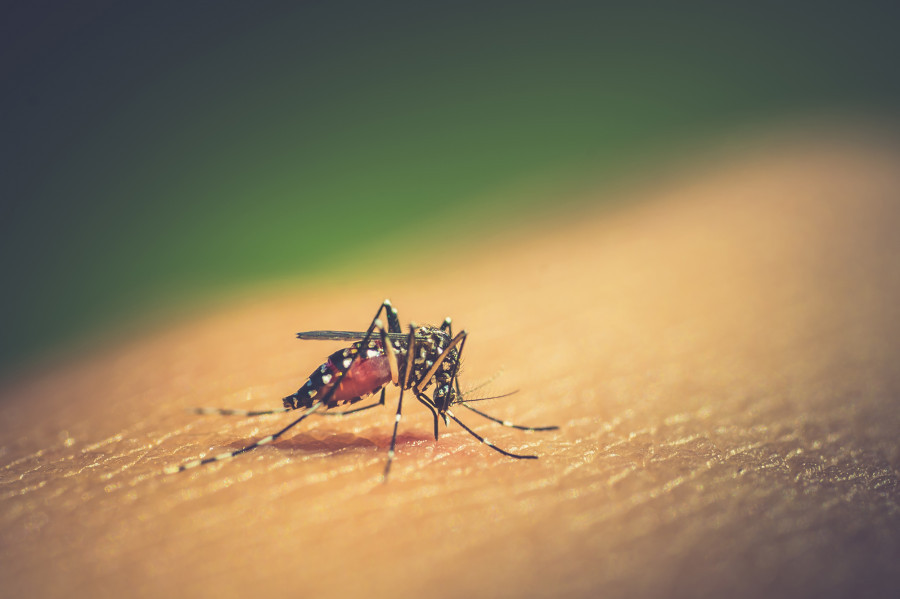
Amid a rapid surge in new dengue cases in the Kathmandu Valley and other big cities, public health experts warn of the risk of a massive outbreak of the disease in the rural areas after the Dashain festival, which falls next month.
Hundreds of thousands of people residing in big cities including in the districts of the Kathmandu Valley will return to their villages in Dashain to celebrate the festival with their families.
“The vector of the dengue virus has been already present in most of the districts,” said Dr Meghnath Dhimal, an expert member of the World Health Organisation-South East Asia Regional Expert Group on Environmental Determinants of Health and Climate Change. “What is necessary for the vector to spread the virus is an infected person which will be fulfilled once infected people return to their villages.”
Cases of dengue infection have been already reported from 75 out of 77 districts throughout the country. What concerns doctors in health facilities in the rural setting is the lack of human resources to deal with emerging new problems.
“The risk of a massive spread of the disease grows once people start returning to their villages from dengue hotspots,” said Dr Sher Bahadur Pun, chief of the Clinical Research Unit at the Sukraraj Tropical and Infectious Disease Hospital. “Local governments should take preventive measures to prevent situations like in the Kathmandu Valley.”
So far, around a dozen people have succumbed to dengue and more than 10,000 infections have been reported from across the country. Experts say reported cases of dengue could be just the tip of the iceberg, as around 90 percent of the infected people do not show any symptoms.
The deadly virus has been detected every month since January. The viral disease has already become endemic to Nepal, public health experts say.
Dengue is a mosquito-borne disease transmitted by female Aedes aegypti and Aedes albopictus mosquitoes. The same vector also transmits chikungunya, yellow fever, and Zika viruses, according to the World Health Organisation.
Although the post-monsoon period is considered a high transmission season for dengue, Nepal has witnessed outbreaks of the deadly disease since the beginning of the year and in the pre-monsoon, monsoon, and post-monsoon seasons.
Asymptomatic people can easily spread the disease through vectors [disease-carrying mosquitoes], according to experts.
Mild to high fever, severe muscle pain, rashes, severe headache, and pain in the eyes are some of the symptoms of dengue, according to doctors.
Lalitpur and Kathmandu top the list of districts severely affected by the dengue virus.
Lalitpur has reported over 4,000 cases as of Tuesday, according to Satish Bista, chief of the Health Office, Lalitpur.
“Three deaths from dengue have been reported in our district (Lalitpur). Two of the deaths were confirmed by hospitals and we have been working to verify the cause of the third death,” said Bista.
Launching awareness campaigns on the risk of infection, and search and destroy drives are among the measures taken by authorities concerned to lessen the spread of dengue.
Meanwhile, the Epidemiology and Disease Control Division said it is mulling insecticide fogging in the highly affected areas like Kathmandu Valley to lessen the spread of the virus.
“We have been discussing if insecticide fogging would be effective to control the spread of infection in the highly affected areas, but no decision has been taken so far,” said Dr Gokarna Dahal, chief of the Vector Control Section, at the division. “We have requested local governments to launch awareness and search and destroy drives in their jurisdictions regularly.”
Experts say insecticide fogging is a more technical and costly technique and instead suggest focusing on the elimination of mosquito breeding sites.
Dahal concedes the risk of a massive spread of the virus in rural areas after Dashain but said that unless local authorities and communities themselves shoulder the responsibility to destroy breeding sites of the virus spreading vectors, it will be difficult to control the ongoing epidemic.
“The disease may not come under control until Dashain, and we could see a massive surge after Dashain,” said Dahal.
In 2019, at least six people died and over 17,000 were hospitalised with dengue fever. The outbreak, which had started in the pre-monsoon period from Dharan, spread to 68 districts.
The World Health Organisation says there is no specific treatment for severe dengue, but early detection and access to proper medical care can lower the fatality rate.












